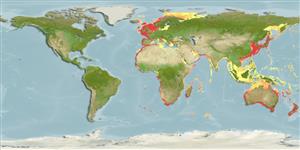Preferred temperature (Ref.
123201): 6.7 - 23.7, mean 13.6 °C (based on 1223 cells).
Índice de diversidade filogenética (Ref.
82804): PD
50 = 0.7656 [Uniqueness, from 0.5 = low to 2.0 = high].
Bayesian length-weight: a=0.01660 (0.01360 - 0.02025), b=2.91 (2.85 - 2.97), in cm total length, based on LWR estimates for this species (Ref.
93245).
Nível Trófico (Ref.
69278): 4.5 ±0.8 se; based on diet studies.
Resiliência (Ref.
120179): médio(a), tempo mínimo de duplicação da população 1,4 - 4,4 anos (K=0.15; tm=3-4; tmax=12).
Prior r = 0.74, 95% CL = 0.49 - 1.10, Based on 1 full stock assessment.
Fishing Vulnerability (Ref.
59153): Moderate vulnerability (39 of 100).
🛈
Climate Vulnerability (Ref.
125649): Moderate vulnerability (38 of 100).
🛈
Nutrients (Ref.
124155): Calcium = 14.1 [8.1, 27.2] mg/100g; Iron = 0.246 [0.139, 0.432] mg/100g; Protein = 19.2 [16.0, 21.6] %; Omega3 = 0.65 [0.34, 1.23] g/100g; Selenium = 21 [10, 42] μg/100g; VitaminA = 16.8 [4.4, 66.5] μg/100g; Zinc = 0.368 [0.254, 0.546] mg/100g (wet weight); based on
nutrient studies. 